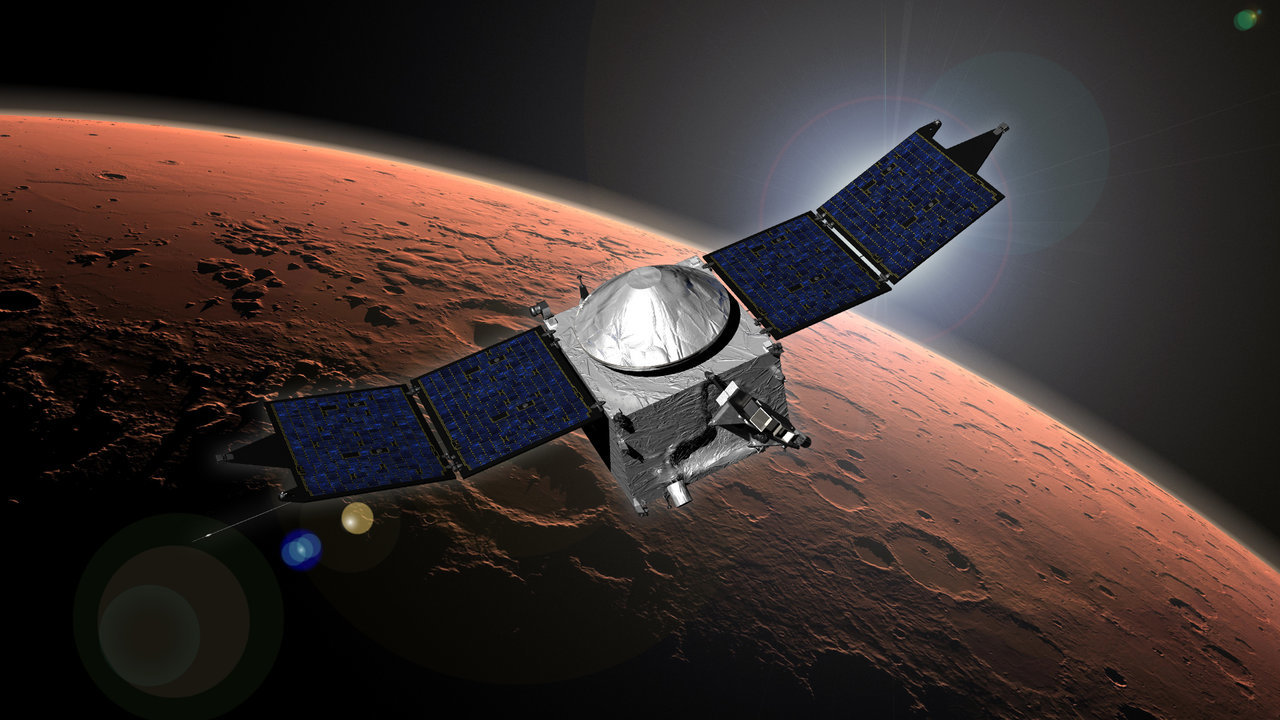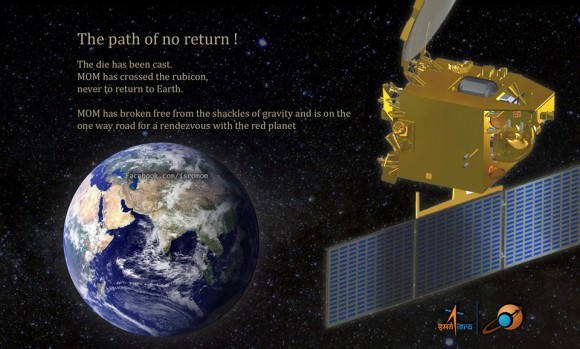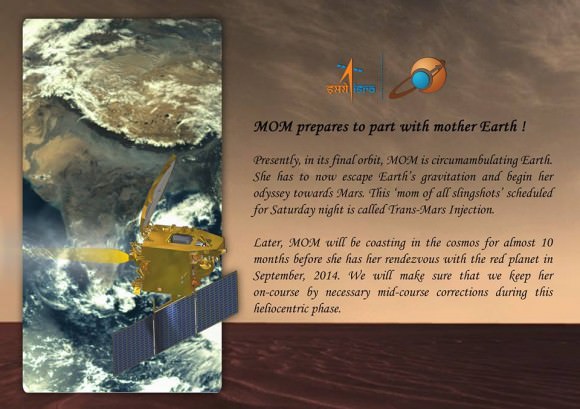After orbiting Mars for eight long years, NASA’s Mars Atmosphere and Volatile EvolutioN (MAVEN) spacecraft observed an extraordinary duo of auroras around the Red Planet that resulted from solar storms emanating from the Sun only a few days earlier on August 27. This observation is extraordinary since Mars lacks a global magnetic field so the solar flares must have been very powerful for MAVEN to detect them.
Continue reading “NASA’s MAVEN Witnessed Auroras as Multiple Solar Storms Crashed into Mars”Mars Might Have Lost its Water Quickly

Mars is an arid place, and aside from a tiny amount of water vapour in the atmosphere, all water exists as ice. But it wasn’t always this arid. Evidence of the planet’s past wet chapter dots the surface. Paleolakes like Jezero Crater, soon to be explored by NASA’s Perseverance Rover, provide stark evidence of Mars’ ancient past. But what happened to all that water?
It disappeared into space, of course. But when? And how quickly?
Continue reading “Mars Might Have Lost its Water Quickly”Mars Has Auroras Too, We Just Can’t See Them
Our eyes can’t see them, but Martian auroras are there, and more commonplace than we once thought. The Martian auroras were first discovered in 2016 by NASA’s MAVEN spacecraft. Now some new results are expanding our knowledge of these unusual auroras.
Continue reading “Mars Has Auroras Too, We Just Can’t See Them”When Martian Storms Really Get Going, they Create Towers of Dust 80 Kilometers High

When a huge dust storm on Mars—like the one in 2018—reaches its full power, it can turn into a globe-bestriding colossus. This happens regularly on Mars, and these storms usually start out as a series of smaller, runaway storms. NASA scientists say that these storms can spawn massive towers of Martian dust that reach 80 km high.
And that phenomenon might help explain how Mars lost its water.
Continue reading “When Martian Storms Really Get Going, they Create Towers of Dust 80 Kilometers High”Martian Clouds Might Start with Meteor Trails Through the Atmosphere
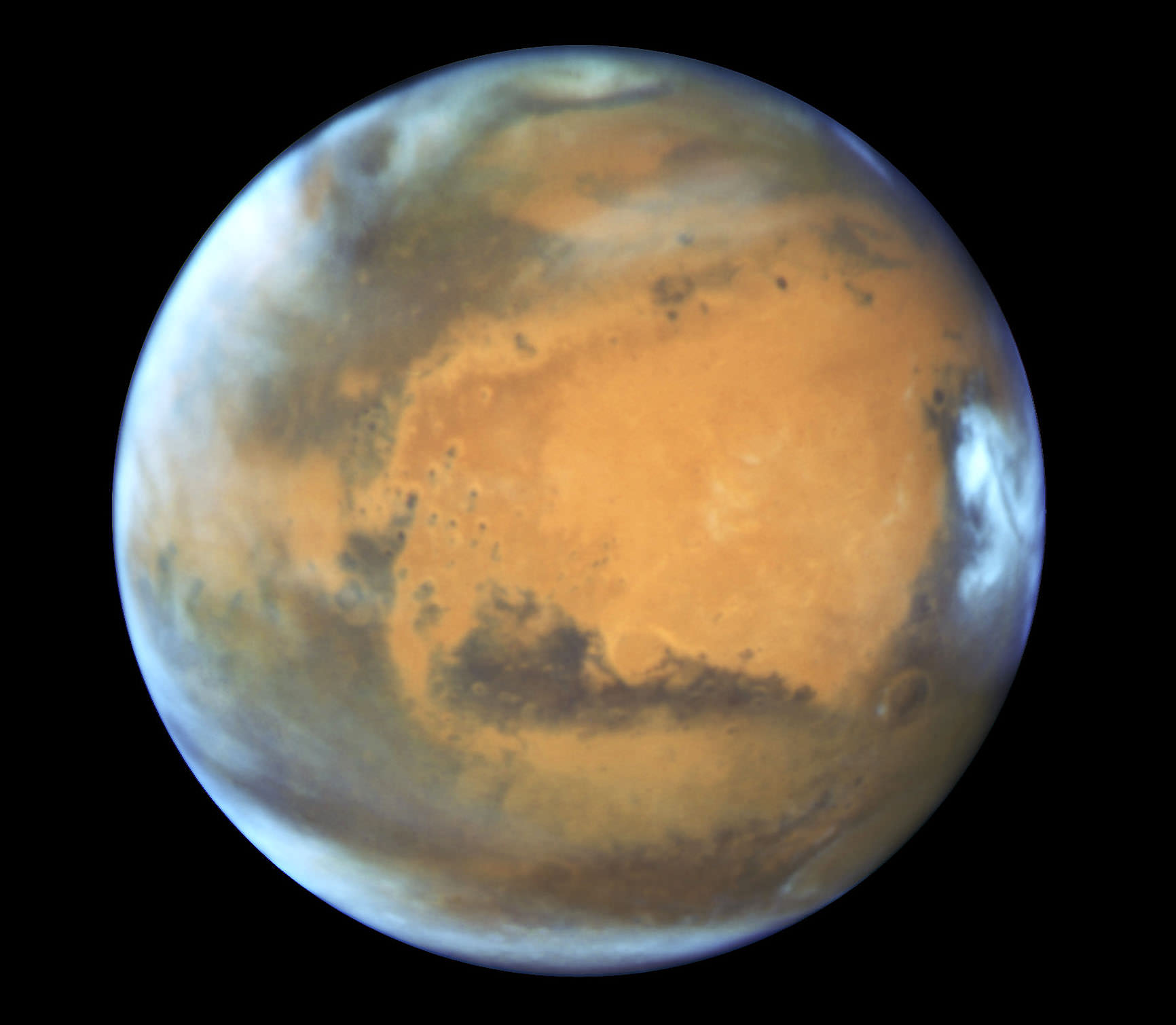
On Earth, clouds form when enough droplets of water condense out of the air. And those droplets require a tiny speck of dust or sea salt, called a condensation nuclei, to form. In Earth’s atmosphere, those tiny specks of dust are lofted high into the atmosphere where they trigger cloud formation. But on Mars?
Mars has something else going on.
Continue reading “Martian Clouds Might Start with Meteor Trails Through the Atmosphere”2 Days Out from the Red Planet, India’s MOM Probe Test Fires Main Engine for Mars Orbit Insertion
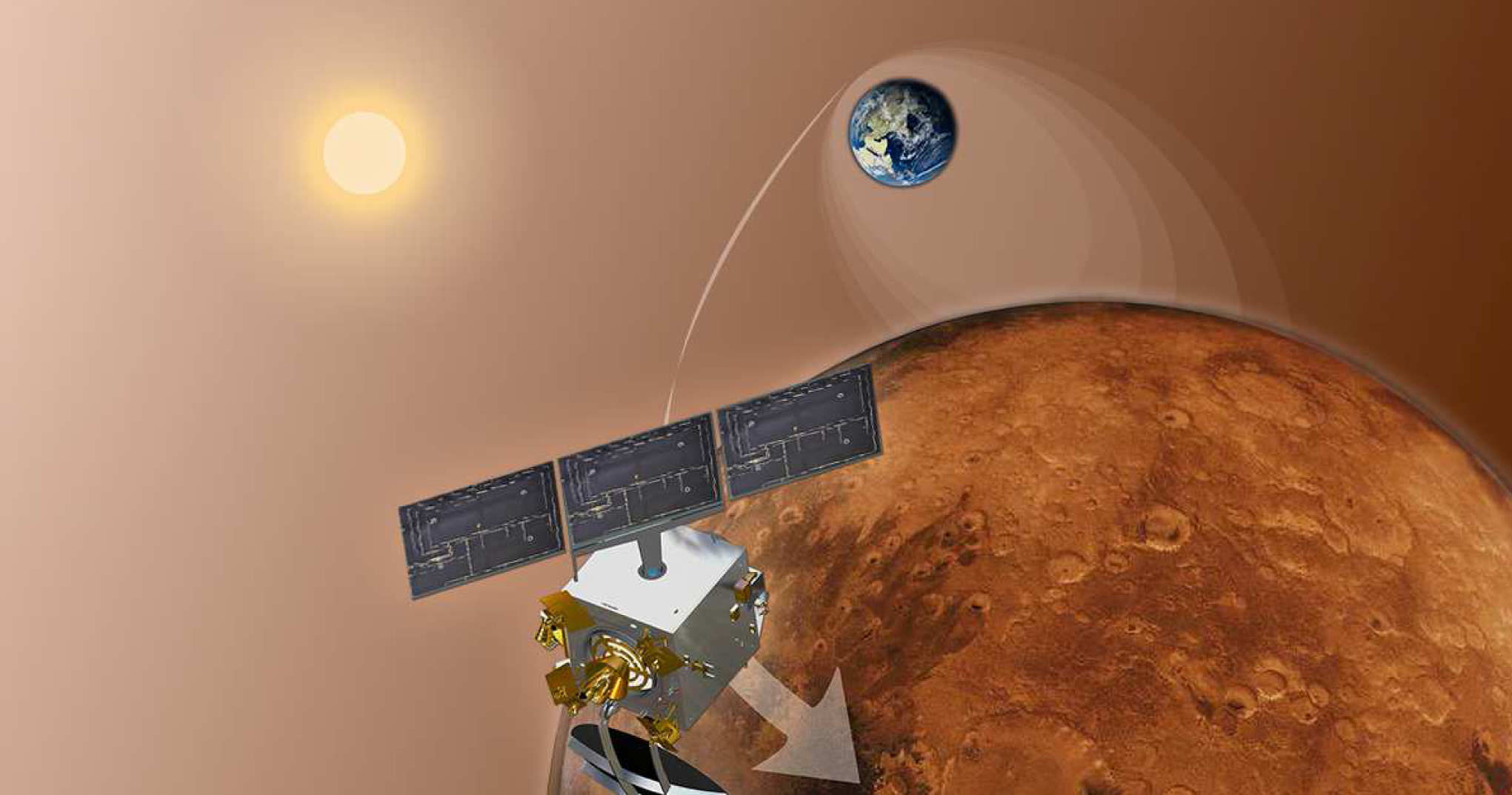
Two days out from her history making date with destiny, India’s Mars Orbiter Mission (MOM) successfully completed a crucial test firing of the spacecraft’s main liquid engine to confirm its operational readiness for the critical Mars Orbital Insertion (MOI) engine firing on Wednesday morning Sept. 24 IST (Tuesday evening Sept. 23 EDT).
Engineers at the Indian Space Research Organization (ISRO) which designed and developed MOM successfully fired the probes 440 Newton Liquid Apogee Motor (LAM) earlier today, Sept. 22, 2014, for a duration of 3.968 seconds at 1430 hrs IST (Indian Standard Time), according to today’s announcement from ISRO.
“We had a perfect burn for four seconds as programmed. MOM will now go-ahead with the nominal plan for Mars Orbital Insertion,” said ISRO.
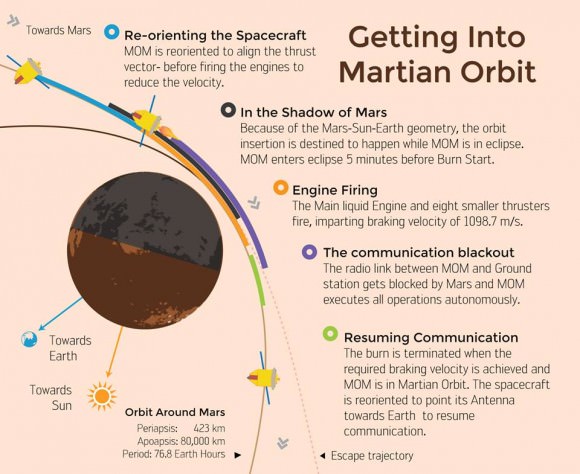
MOM counts as India’s first interplanetary voyager and the nation’s first manmade object to orbit the 4th rock from our Sun – if all goes well.
The LAM was last fired over nine months ago on December 01, 2013 to inject MOM into a ten month long interplanetary Trans Mars Trajectory.
Today’s operation verified that LAM is fully operational to perform the do-or-die MOI braking burn on Sept. 24 targeted for 07:17:32 hrs IST (Sept. 23, 9:47:32 p.m. EDT) that will place the probe into a highly elliptical 377 km x 80,000 km orbit around the Red Planet.
You can watch all the action live on ISRO’s website during the streaming webcast starting at 6:45 IST (9:15 p.m. EDT): http://www.isro.org/
The burn was also marks the spacecraft’s final Trajectory Correction Maneuver known as TCM-4 and changed its velocity by 2.18 meters/second.
“The trajectory has been corrected,” said ISRO.
The $69 Million probe is being continuously monitored by the Indian Deep Space Network (IDSN) and NASA JPL’s Deep Space Network (DSN) to maintain its course.
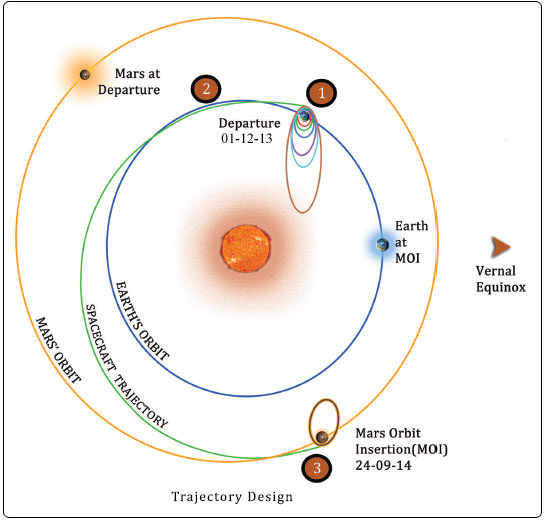
ISRO space engineers are taking care to precisely navigate MOM to keep it on course during its long heliocentric trajectory from Earth to Mars through a series of in flight Trajectory Correction Maneuvers (TCMs).
The last TCM was successfully performed on June 11 by firing the spacecraft’s 22 Newton thrusters for a duration of 16 seconds. TCM-1 was conducted on December 11, 2013 by firing the 22 Newton Thrusters for 40.5 seconds.
Engineers determined that a TCM planned for August was not needed.
On “D-Day” as ISRO calls it, the LAM and the eight smaller 22 Newton liquid fueled engines are scheduled to fire for a duration of about 24 minutes.
The MOI braking burn will be carried out fully autonomously since MOM will be eclipsed by Mars due to the Sun-Earth-Mars geometry about five minutes prior to initiation of the engine firing.
Round trip radio signals communicating with MOM now take some 21 minutes.
The 1,350 kilogram (2,980 pound) probe has been streaking through space for over ten months.
MOM follows hot on the heels of NASA’s MAVEN spacecraft which successfully achieved Red Planet orbit less than a day ago on Sunday, Sept. 22, 2014.
“We wish a successful MOI for MOM,” said Bruce Jakosky, MAVEN principal investigator with the Laboratory for Atmospheric and Space Physics at the University of Colorado, Boulder (CU/LASP) at MAVEN’s post MOI briefing earlier today.
MOM was launched on Nov. 5, 2013 from India’s spaceport at the Satish Dhawan Space Centre, Sriharikota, atop the nation’s indigenous four stage Polar Satellite Launch Vehicle (PSLV) which placed the probe into its initial Earth parking orbit.
Watch this cool animation showing the interplanetary path of MOM and MAVEN from Earth to Mars sent to me be an appreciative reader – Sankaranarayanan K V:
Although MOM’s main objective is a demonstration of technological capabilities, she will also study the planet’s atmosphere and surface.
The probe is equipped with five indigenous instruments to conduct meaningful science – including a tri-color imager (MCC) and a methane gas sniffer (MSM) to study the Red Planet’s atmosphere, morphology, mineralogy and surface features. Methane on Earth originates from both geological and biological sources – and could be a potential marker for the existence of Martian microbes.
Both MAVEN’s and MOM’s goal is to study the Martian atmosphere , unlock the mysteries of its current atmosphere and determine how, why and when the atmosphere and liquid water was lost – and how this transformed Mars’ climate into its cold, desiccated state of today.
If all goes well, India will join an elite club of only four who have launched probes that successfully investigated the Red Planet from orbit or the surface – following the Soviet Union, the United States and the European Space Agency (ESA).
Stay tuned here for Ken’s continuing MOM, MAVEN, Rosetta, Opportunity, Curiosity, Mars rover and more Earth and planetary science and human spaceflight news.
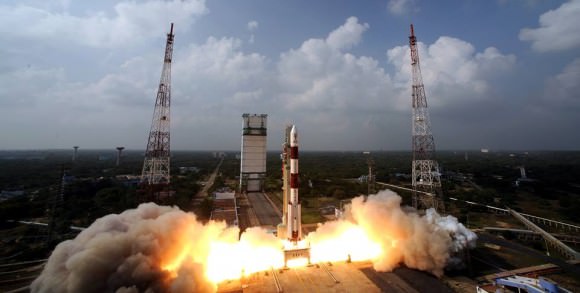
India’s First Mars Probe ‘MOM’ Blasts Free of Earth Joining MAVEN in Race to Red Planet
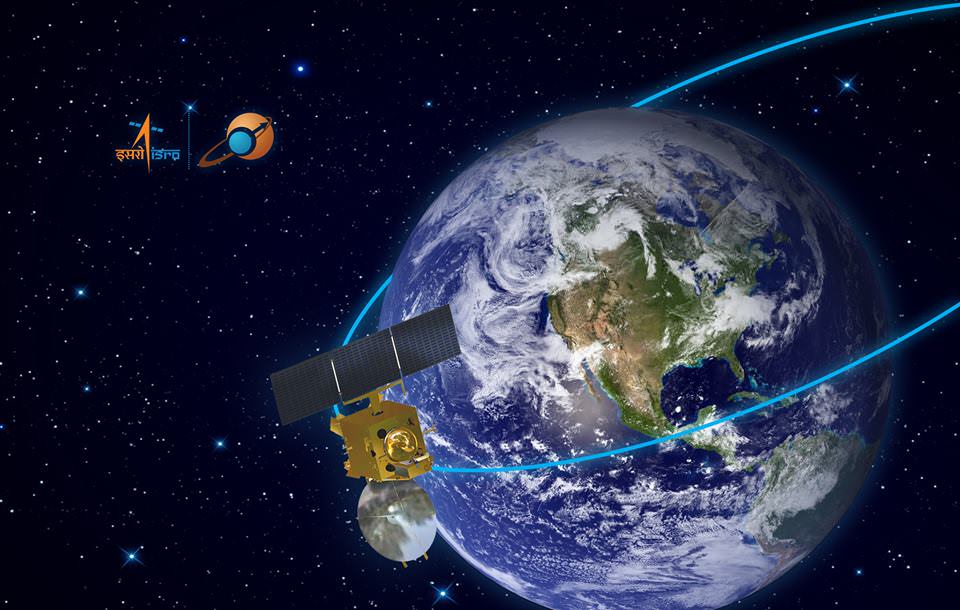
CAPE CANAVERAL, FL – India’s first ever Mars probe ‘MOM’ successfully fired its main engine today (Dec. 1), blasting the craft free of the Earth’s sphere of influence forever to begin her nearly yearlong momentous voyage to the Red Planet.
Indian space engineers initiated the 440 Newton liquid fueled engine firing precisely as planned at 00:49 hrs (IST) on Sunday, Dec. 1, 2013 during a critical nail-biting burn lasting some 22 minutes.
The Trans Mars Insertion (TMI) firing propelled India’s Mars Orbiter Mission (MOM) away from Earth forever and placed the spacecraft on course for a rendezvous with the Red Planet on September 24, 2014 – where it will study the atmosphere and sniff for signals of methane.
Sunday’s Mars insertion burn imparted the vehicle with an incremental velocity of 647.96 meters per second (m/sec) consuming 198 kg of fuel.

The maneuver dubbed ‘The mother of all slingshots’, enabled MOM to finally achieve escape velocity and catapulted the 1,350 kilogram (2,980 pound) spacecraft on an historic flight streaking towards Mars.
And in a rare but rather delightful coincidence, MOM is not alone on her remarkable Martian sojourn. Following the triumphant engine burn, she now joins NASA’s MAVEN orbiter in a gallant marathon race to the Red Planet.
MOM was designed and developed by the Indian Space Research Organization’s (ISRO) at a cost of $69 Million and marks India’s inaugural foray into interplanetary flight.
“The Earth orbiting phase of the spacecraft ended,” with this maneuver said ISRO.
MOM is healthy and all systems are functioning normally.
While MOM was cycling Earth, ISRO scientists and engineers activated and tested the probes systems and science payloads.
They also turned the crafts color camera homewards to capture the “First ever image of Earth Taken by Mars Color Camera,” according to ISRO.

MOM is nicknamed ‘Mangalyaan’ – which in Hindi means ‘Mars craft.’
MOM’s journey bagen with a picture perfect Nov. 5 liftoff atop India’s highly reliable four stage Polar Satellite Launch Vehicle (PSLV) C25 from ISRO’s Satish Dhawan Space Centre SHAR, Sriharikota.
The PSLV booster precisely injected MOM into an initial elliptical Earth parking orbit of 247 x 23556 kilometers with an inclination of 19.2 degrees.
PSLV does not have sufficient thrust to send MOM streaking directly to the Red Planet.
Therefore since the flawless launch, the engine has been fired 6 times on November 7, 8, 9, 11, and 16 plus one supplementary maneuver to gradually raise the spacecrafts apogee from 23556 km to 192,874 km.
The most recent orbit raising maneuver occurred on Nov 16, 2013 with a burn time of 243.5 seconds and increased the apogee from 118,642 km to 192,874 km.
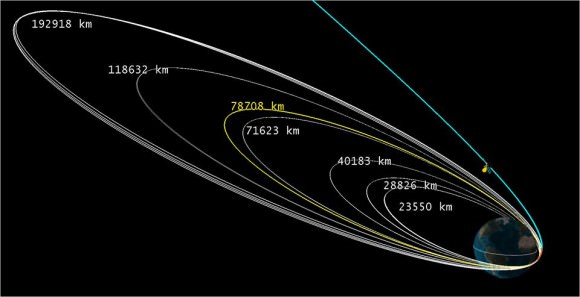
Today’s burn was the final one around Earth and absolutely crucial for setting her on course for Mars.
MOM was the first of two missions dispatched to Mars by Earthlings this November.
Half a world away, NASA’s MAVEN orbiter blasted off on Nov. 18 from Cape Canaveral Air Force Station, Florida atop an Atlas V booster on a direct path to the Red Planet.
The MOM spacecraft is now on traveling on a heliocentric elliptical trajectory to begin a 300 day long interplanetary voyage of more than 700 Million kilometers (400 Million miles) to the Red Planet.
Along the path to Mars, ISRO plans to conduct a series of Trajectory Correction Maneuvers (TCMs) using MOM’s Attitude and Orbit Control System (AOCS) thrusters to precisely navigate the probe to the point required to achieve orbit around the Red Planet
Following the ten month cruise through space the orbital insertion engine will fire for a do or die burn on September 24, 2014 placing MOM into an 377 km x 80,000 km elliptical orbit around Mars.
MOM will reach Mars vicinity just two days after MAVEN’s arrival on Sept. 22, 2014.
If all continues to goes well, India will join an elite club of only four who have launched probes that successfully investigated the Red Planet from orbit or the surface – following the Soviet Union, the United States and the European Space Agency (ESA).
Both MAVEN and MOM’s goal is to study the Martian atmosphere, unlock the mysteries of its current atmosphere and determine how, why and when the atmosphere and liquid water was lost – and how this transformed Mars climate into its cold, desiccated state of today.
Although MOM’s main objective is a demonstration of technological capabilities, the probe is equipped with five indigenous instruments to conduct meaningful science – including a multi color imager and a methane gas sniffer to study the Red Planet’s atmosphere, morphology, mineralogy and surface features. Methane on Earth originates from both geological and biological sources – and could be a potential marker for the existence of Martian microbes.
MOM’s 15 kg (33 lb) science suite comprises:
MCM: the tri color Mars Color Camera images the planet and its two tiny moons, Phobos and Deimos
LAP: the Lyman Alpha Photometer measures the abundance of hydrogen and deuterium to understand the planets water loss process
TIS: the Thermal Imaging Spectrometer will map surface composition and mineralogy
MENCA: the Mars Exospheric Neutral Composition Analyser is a quadrapole mass spectrometer to analyze atmospheric composition
MSM: the Methane Sensor for Mars measures traces of potential atmospheric methane down to the ppm level.
Scientists will be paying close attention to whether MOM detects any atmospheric methane to compare with measurements from NASA’s Curiosity rover – which found ground level methane to be essentially nonexistent – and Europe’s upcoming 2016 ExoMars Trace Gas Orbiter.
India’s MOM – ‘Mangalyaan’ mission is expected to continue gathering measurements at the Red Planet for at least six months and hopefully much longer.
MAVEN could operate for a decade or longer and is also crucial for relaying images and data collected by NASA’s current and upcoming surface rovers and landers.
Although they were developed independently and have different suites of scientific instruments, the MAVEN and MOM science teams will “work together” to unlock the secrets of Mars atmosphere and climate history, MAVEN’s top scientist told Universe Today.
“We have had some discussions with their science team, and there are some overlapping objectives,” Bruce Jakosky told me. Jakosky is MAVEN’s principal Investigator from the University of Colorado at Boulder.
“At the point where we [MAVEN and MOM] are both in orbit collecting data we do plan to collaborate and work together with the data jointly,” Jakosky said.
Stay tuned here for continuing MOM and MAVEN news and Ken’s MAVEN and SpaceX Falcon 9 launch reports from on site at the Kennedy Space Center press center and Cape Canaveral Air Force Station, Florida.
Mother of All Slingshots Set to Hurl India’s MOM Probe to Mars
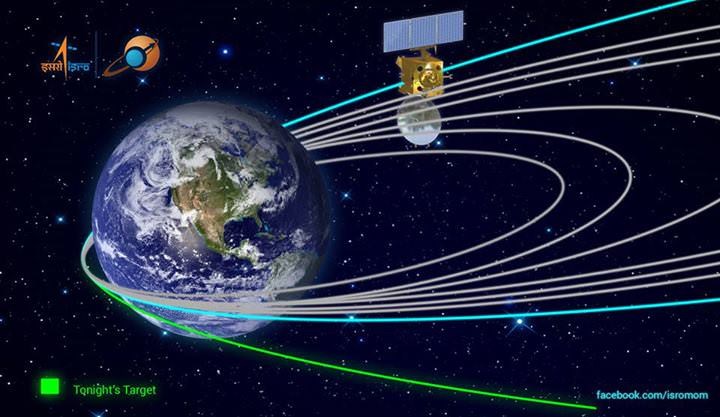
CAPE CANAVERAL, FL – MOM – India’s first ever interplanetary spacecraft – is spending her last day around Mother Earth.
The clock is ticking down relentlessly towards “The mother of all slingshots” – the critical engine firing intended to hurl India’ Mars Orbiter Mission (MOM) probe on her ten month long interplanetary cruise to the Red Planet.
Engineers at the Indian Space Research Organization’s (ISRO) Mission Operations Complex at Bangalore are now just hours away from sending the commands that will ignite MOMs’ liquid fueled main engine for TMI – the Trans Mars Insertion maneuver that will propel MOM away from Earth forever and place the craft on an elliptical trajectory to the Red Planet.
“Performance assessment of all subsystems of the spacecraft has been completed,” reports ISRO.
The do or die 1351 second burn is slated to begin at 00:49 hrs IST tonight – on Dec. 1 Indian local time.
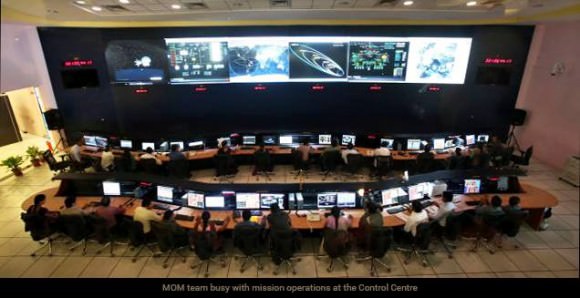
The 440 Newton liquid fueled main engine must fire precisely as planned to inject MOM on target to Mars.
MOM’s picture perfect Nov. 5 liftoff atop India’s highly reliable four stage Polar Satellite Launch Vehicle (PSLV) C25 from the ISRO’s Satish Dhawan Space Centre SHAR, Sriharikota, precisely injected the spacecraft into an initial elliptical Earth parking orbit of 247 x 23556 kilometers with an inclination of 19.2 degrees.

Since then the engine has fired 6 times to gradually raise the spacecrafts apogee.
The most recent orbit raising maneuver occurred at 01:27 hrs (IST) on Nov 16, 2013 with a burn time of 243.5 seconds increased the apogee from 118,642 km to 192,874 km.
Tonight burn is MOM’s final one around Earth and absolutely crucial for setting her on course for Mars.
If all goes well the $69 million MOM spacecraft reaches the vicinity of Mars on 24 September 2014.
MOM was the first of two Earth missions to Mars launched this November.
NASA’s $671 Million MAVEN orbiter launched as scheduled on Nov. 18, from Cape Canaveral, Florida and arrives at Mars on Sept. 22, 2014, about two days before MOM.
Both MAVEN and MOM’s goal is to study the Martian atmosphere, unlock the mysteries of its current atmosphere and determine how, why and when the atmosphere and liquid water was lost – and how this transformed Mars climate into its cold, desiccated state of today.
Stay tuned here for continuing MOM and MAVEN news and Ken’s MAVEN and SpaceX Falcon 9 launch reports from on site at the Kennedy Space Center press center and Cape Canaveral Air Force Station, Florida.
Curiosity Mars Rover Back in Action after Power Glitch
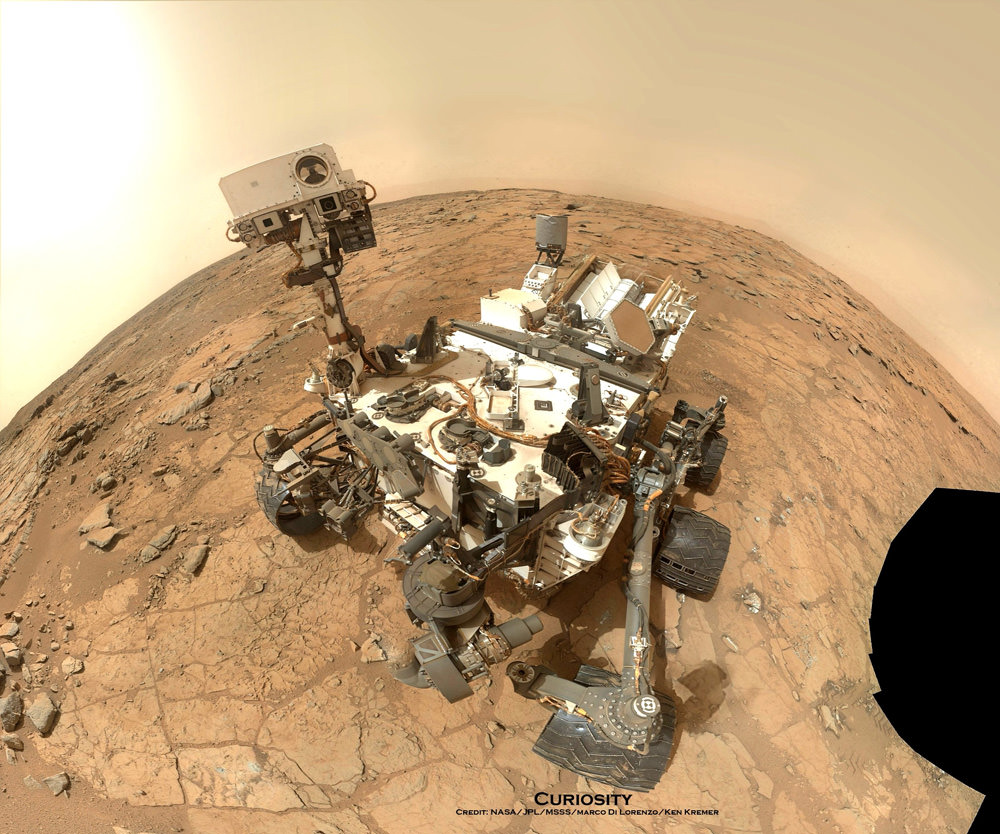
CAPE CANAVERAL, FL – NASA’s car sized Curiosity Mars rover has resumed full science operations and driving following a six day long halt to research activities due to concerns about an electrical power system glitch, which have now been resolved.
On Nov. 17, engineers noticed a fluctuation in voltage on Curiosity that caused the robots handlers to stop science activities and driving towards mysterious Mount Sharp while they searched for the root cause of the electrical issue.
NASA says that the voltage change did not impact the rovers safety or health and the team was acting out of an abundance of caution while investigating the situation from millions of miles away back on Earth.
“The vehicle’s electrical system has a “floating bus” design feature to tolerate a range of voltage differences between the vehicle’s chassis — its mechanical frame — and the 32-volt power lines that deliver electricity throughout the rover. This protects the rover from electrical shorts,” NASA said in a statement.
Curiosity’s voltage level had been about 11 volts since landing day and had declined to about 4 volts on Nov. 17. The electrical issue did not trigger the rover to enter a safe-mode status.

Engineers amassed a list of possible causes for the voltage change while suspending science operations and roving across the Martian crater floor where Curiosity landed nearly a year and a half ago in August 2012.
“We made a list of potential causes, and then determined which we could cross off the list, one by one,” said rover electrical engineer Rob Zimmerman of NASA’s Jet Propulsion Laboratory, Pasadena, Calif.
NASA says that the likely cause is an internal short stemming from the Radioisotope Thermoelectric Generator (RTG) – the rovers nuclear power source.
RTG’s have been commonly used on many NASA missions that also experienced occasional shorts and that had no long term impact or loss of capability on their flights.
“This type of intermittent short has been seen in similar RTGs, including the one on the Cassini spacecraft, which has been orbiting Saturn for years. The rover electronics are designed to operate at variable power supply voltages, so this is not a major problem,” says Curiosity team member Ken Herkenhoff of the USGS in a mission update.
The voltage level had returned its normal level of 11 volts on its own by Nov. 23, when the team had decided to resume science operations.
So it is possible that the same type of intermittent voltage change could recur in the future.
Meanwhile the rover has resumed her epic trek to Mount Sharp and is expected to arrive at the base of the mountain sometime in mid-2014.
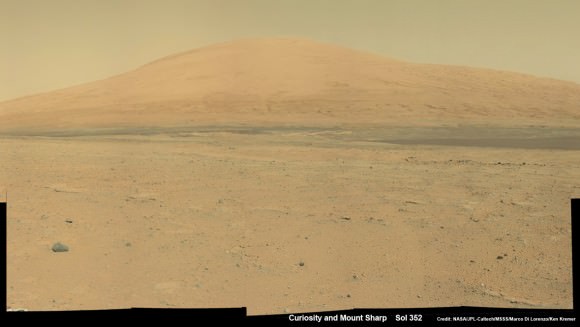
This past weekend, the robot delivered additional portions of powdered rock to the CheMin and SAM labs inside the rover. The sample was collected 6 months ago after drilling into a rock nicknamed “Cumberland” and will supplement prior measurements.
Curiosity has already accomplished her primary science goal of discovering a habitable zone at her landing site.
Scientists expect to broaden the region of Martian habitability once the 1 ton robot begins the ascent of Mount Sharp to investigate the sedimentary layers in the lower reaches of the towering 3 mile (5 km) high mountain, that record Mars geologic and climatic history over a time span of billions of years.
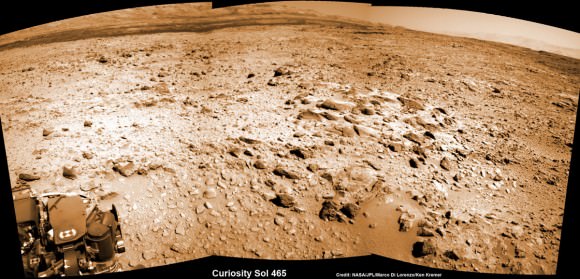
And as both of NASA’s rovers Curiosity and Opportunity ascend Martian mountains, they’ll be joined next September 2014 by a pair of new Martian orbiters from the US and India – MAVEN and MOM – that will significantly expand Earth’s invasion force at the Red Planet.
Stay tuned here for continuing Mars rover, MOM and MAVEN news and Ken’s MAVEN and SpaceX Falcon 9 launch reports from on site at the Kennedy Space Center press center and Cape Canaveral Air Force Station, Florida.
India’s MOM Mars Probe Images Earth’s Children Prior to Nail Biting Red Planet Insertion

CAPE CANAVERAL, FL – MOM is looking at you, kid!
And if the spectacular new image of billions of Earth’s children captured by India’s Mars Orbiter Mission (MOM) is any indication (see above), then we can expect absolutely gorgeous scenes of the Red Planet once the groundbreaking probe arrives there in September 2014.
But despite all that’s been accomplished so far, the space drama is still in its infant stages – because MOM still needs to ignite her thrusters this weekend in order to achieve escape velocity, wave good bye to Earth forever and eventually say hello to Mars!
The picture – snapped from Earth orbit – is focused on the Indian subcontinent, the probes origin.
MOM has captured the imagination of space enthusiasts worldwide.
And she’s the pride of all India – as the country’s first ever interplanetary space mission.
During testing of the MOM probes payloads – while it’s still flying in a highly elliptical orbit around our Home Planet – engineers from India’s space agency turned the crafts camera homewards to capture the “First ever image of Earth Taken by Mars Color Camera,” according to the Indian Space Research Organization (ISRO).
The beautiful image was taken on Nov. 20 at around 1350 hrs (IST) from a height of almost 70,000 km above earth and has a spatial resolution of 3.5 km, said ISRO.
The image also gives a rather good approximation of what MOM’s color camera will actually see from apoapsis after reaching the Red Planet since the probe will enter a similarly highly elliptical orbit around Mars – ranging in altitude from 366 kilometers (km) x 80,000 kilometers (km).
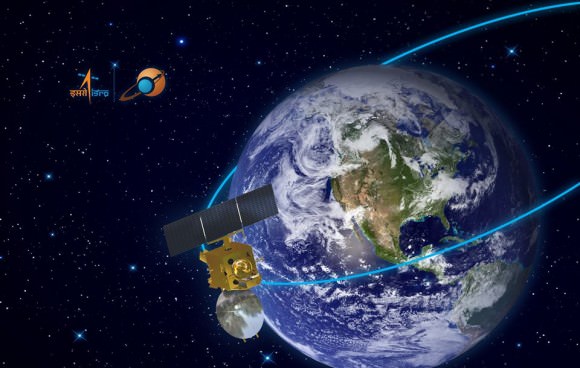
Following a 10 month interplanetary cruise, MOM is due to arrive in the vicinity of Mars on September 24, 2014 to study the Red Planets’ atmosphere.
At that time, the 440 Newton liquid fueled main engine must fire precisely as planned during the absolutely essential Mars orbital insertion burn to place the probe into orbit about Mars.
But before MOM can accomplish anything at Mars, she must first successfully fire her main engine – to complete the crucial departure from Earth and Trans Mars Insertion (TMI) scheduled for this Saturday!
MOM’s picture perfect Nov. 5 liftoff atop India’s highly reliable four stage Polar Satellite Launch Vehicle (PSLV) C25 from the ISRO’s Satish Dhawan Space Centre SHAR, Sriharikota, precisely injected the spacecraft into an initial elliptical Earth parking orbit of 247 x 23556 kilometers with an inclination of 19.2 degrees.
Since then the engine has fired 6 times to gradually raise the spacecrafts apogee.
The most recent orbit raising maneuver occurred at 01:27 hrs (IST) on Nov 16, 2013 with a burn time of 243.5 seconds increased the apogee from 118,642 km to 192,874 km.
The nail-biting final main engine burn of 1351 seconds is set for this weekend on Dec. 1. It will place MOM on a precise interplanetary trajectory to the Red Planet.
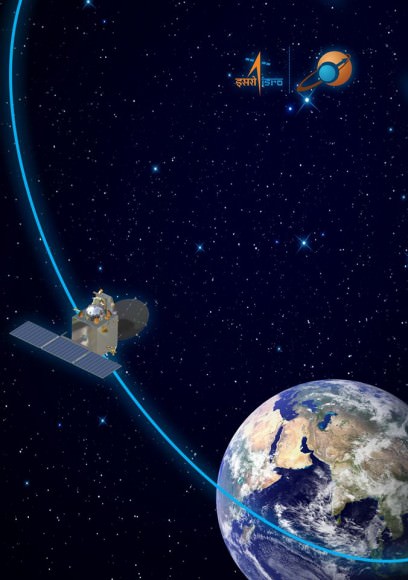
If all continues to goes well, India will join an elite club of only four who have launched probes that successfully investigated the Red Planet from orbit or the surface – following the Soviet Union, the United States and the European Space Agency (ESA).
The low cost $69 Million MOM mission is the first of two new Mars orbiter science probes from Earth that flawlessly blasted off for the Red Planet this November.
Half a world away, NASA’s $671 Million MAVEN orbiter launched as scheduled on Nov. 18 – from Cape Canaveral, Florida.
Both MAVEN and MOM’s goal is to study the Martian atmosphere, unlock the mysteries of its current atmosphere and determine how, why and when the atmosphere and liquid water was lost – and how this transformed Mars climate into its cold, desiccated state of today.
The MAVEN and MOM science teams will “work together” to unlock the secrets of Mars atmosphere and climate history, MAVEN’s top scientist Prof. Bruce Jakosky told Universe Today.
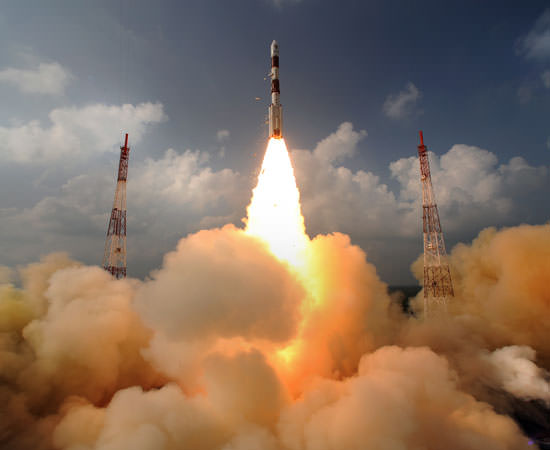
Stay tuned here for continuing MOM and MAVEN news and Ken’s MAVEN and SpaceX Falcon 9 launch reports from on site at the Kennedy Space Center press center and Cape Canaveral Air Force Station, Florida.
…………….
Learn more about MOM, MAVEN, Mars rovers, SpaceX, Orion and more at Ken’s upcoming presentations
Nov 28: “SpaceX launch, MAVEN & MOM Mars Launches and Curiosity Explores Mars, Orion and NASA’s Future”, Kennedy Space Center Quality Inn, Titusville, FL, 8 PM
Dec 11: “Curiosity, MAVEN, MOM and the Search for Life on Mars”, “LADEE & Antares ISS Launches from Virginia”, Rittenhouse Astronomical Society, Franklin Institute, Phila, PA, 8 PM

